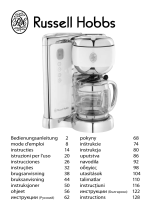10
• Do not use or place any part of the
appliance on or near to hot surfaces (gas
cooker rings, electric hotplates or ovens).
• Do not allow the cord to hang over the
edge of the surface on which it is placed.
Select the minimum length of cord
required to plug it into its electrical
socket.
• Do not touch the hot surfaces of the
appliance. Use the handles. Do not allow
the cord to touch the hotplate.
• In the event that the appliance cord
becomes damaged, contact an
authorised Service Centre to have it
replaced.
• Do not use any electrical appliance with
a damaged cord or plug, which does not
work properly, or which has been
damaged in any way. Take the appliance
to an authorised Service Centre to be
examined, repaired and/or adjusted.
• In the event that the appliance breaks
down or ceases to operate properly,
switch off the appliance without
attempting to repair it. Contact an
authorised Service Centre and ask for
original accessories and parts to be
used.
• In the event that you decide to dispose of
the appliance definitively, it is advisable
to disable it by cutting the power cord,
after having unplugged it from the socket.
If a jug breaks, the hot liquid can cause
burns. To avoid breaking the jug, take the
following precautions.
• Do not let the liquid evaporate. Do not
heat the jug when empty.
• Do not use a broken jug or one with a
loose or weakened handle. Replace it in
the event of any signs of deterioration.
Any crack or chip could break the jug or
contaminate the liquid content with glass
shards.
• Do not clean the jug with any abrasive
scourer or cleaner which might scratch or
weaken the glass.
• Do not heat the jug in the microwave.
Use only cold water to make coffee.
• The jug is designed to be used with this
appliance. Do not place the jug on or
near any hot surface (heater, burner,
cooking hotplate, hot oven, microwave
oven, etc.)
• Do not place the jug on any damp or wet
surface.
• Avoid rough handling or knocks.
•
Before using your coffee maker for the
first time, familiarise yourself with all the
parts. Read all of the instructions
carefully.
•
Dismantle the filter support (9) (fig. 2)
and the jug lid (5) (Fig. 3) and clean
them together with the jug (6), the
permanent filter (10) and the anti-drip
support valve in lukewarm soapy water.
Rinse well, dry and reassemble them,
attaching the anti-drip support valve
correctly to the filter holder
•
To clean inside, operate the coffee
maker twice in succession without
placing ground coffee in the filter. For
this process, follow the instructions
under the section entitled “Preparing the
coffee”.
With the appliance unplugged:
• Place the coffee maker on a flat, stable
surface.
• the open button (2) and ensure that the
container is empty. Fill it with clean, cold
water up to the desired level. Do not
exceed the water container’s maximum
level.
• Fill the filter (10) with the desired amount
of ground coffee and close the lid. We
suggest one dessertspoon of ground
coffee per cup of coffee. After using the
coffee maker several times, you may
adjust the amount of coffee to taste.
• Place the jug (6) with its lid (5) properly
assembled on the hotplate (7). Make
sure that the jug lid opens the anti-drip
valve, otherwise the filtered coffee will
5. MANUAL OPERATION
4. BEFORE USING THE APPLIANCE
FOR THE FIRST TIME








